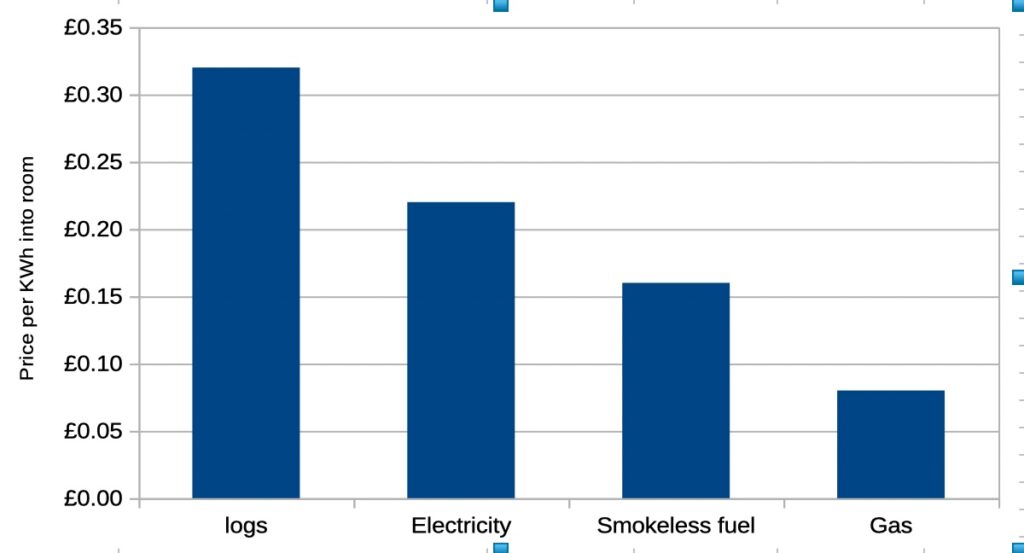 It’s really a multifuel burner (an Aarrow Becton 7). We ran it on smokeless fuel last winter.We were thinking of replacing it with a gas fire last winter but we decided to keep it for another year and run it on logs.
It’s really a multifuel burner (an Aarrow Becton 7). We ran it on smokeless fuel last winter.We were thinking of replacing it with a gas fire last winter but we decided to keep it for another year and run it on logs.
Smokeless fuel is usually dearer than logs per Kg but has a higher heat output. But it takes quite a time for the burner to start giving out heat after lighting and quite a time for it to die down. And it leaves the ashpan full which has to be emptied every day.
Logs start burning hard within minutes, and at the end of the night the fire goes out quickly, and there is very little ash. The ashpan only needs emptying once a week.
Logs are sold by the bag or the net, and the only “proper unit” usually mentioned is litres. Sometimes a net is described as 22 litres.
This reminds me of the chap who went to buy horse manure from a Yorkshire farmer. He said “Do I pay by weight or by volume?”
The farmer replied “Tha can pay ‘ow tha likes. Ah sells it by ‘t shovelful”
This site says:-
All 40 Litre Nets of kiln dried logs, regardless of type of wood are given a weight of 15kgs. As per the characteristics shown above this weight may vary by 5kg either way. That works out at 0.375 Litres per Kg.
That would give a 22 litre net as 8.25Kg average or between 5.5 and 10Kg. How the hell do you measure the volume of a net? The shape is really irregular, and you can hardly see how much water it can contain.
I bought 4 bags of logs from B&M for £6 and the average weight was 6Kg. Although there is no weight or volume on the packaging, I noticed a delivery note in the bax stating 16 litres as the bag size. That also works out as 0.375 litres per Kg
In reality, logs are an awful choice for heating unless you have access to a cheap or free source of logs.
If you have to buy them, at current prices, here is a comparison of costs per KWh into the room:-

Costs are derived as follows:-
Logs around £1 per Kg, ascertained by buying bags from Aldi, B&M, and Lidl and weighing them. Heat output is around 4,5KWh per Kg and stove efficiency is 70%
Electricity (for us) is 22p per KWh, and electric heaters are 100% efficient.
Smokeless fuel around £0.65 per Kg, ascertained by buying 10Kg bags from Lidl at £6.49 Heat output is around 5.5KWh per Kg and stove efficiency is 70%
Gas (for us) is 6.2p per KWh. We have Gas central heating and I and guessing the efficiency of the system at 70%. This is also the efficiency of a good open gas fire, closed ones can be higher.
BUT the log fire is the prettiest. We go through around 3-4 Kg per night so its costs us around £3.50 per night if we just use logs. The central heating is on at the same time, but can’t really get the temperature above 20C by itself on a cold night.
We have found supermarket fuel to be the cheapest, unless we buy in large volumes – and we don’t have enough storage. space.
Here is our experience with supermarket fuels:-
Hardwood logs light easily and the fire must be regulated down to stop them burning too fast.
Softwood logs are cheaper but difficult to light. They and are best put into a fire already burning well on hardwood.
Fuel logs (B&M) are difficult to light and need started off with some hardwood.
Smokeless fuel (Lidl) almost impossible to light by conventional firelighters and kindling. Buns well when added to an already established hardwood fire.
The most economical method for us, at current prices, is to start the fire with one or two birch logs from B&M, then when it is well away, add a coal scuttle full of (its around 3 Kg) on top. This kept the room warm for over four hours. Total cost for 1 birch log (around 0.4Kg =40p) and 3Kg of briquettes is £2.28 or about 1/3 cheaper than logs alone.
At the time of writing, all of our local supermarkets are out of logs. Most still have smokeless fuel. To be really sure of supply fuel should be stocked up in the summer – if storage is available.
The Future
Gas MAY be more reliable but.:-

If the gas is low, then the electricity is low too:-
I suspect this is simply clickbait. How much gas can we store anyway? The UK, just like me, has limited storage space. I’m sure that not all journalists are lazy buggers, but nowadays most of them are.
We can currently keep our extra heating costs down to around £2.50 per night using logs and smokeless fuel. We are using and extra an extra 15KWh or 10KWh into the room. We do this for around 100 days per year so it is costing us an extra £250 on top of our usual bills.
If we replaced the stove with a gas fire it would be around £1 per night saving us £150 per year. But the gas fire plus installation will cost us around £2500 – so the payback period, at current prices, is 16 years. I suspect gas will get dearer soon.
Currently gas is used to produce electricity. In the not too distant future we may see solar, wind, hydro, and nuclear generated electricity being used to produce hydrogen gas. In the 60s, before the conversion to North Sea gas we used coal gas which was 50% hydrogen, together with other hydrocarbons like methane, catbon monoxide and ethylene
If we replaced the stove with an electric heater it currently would be £2.2 per night. No cost savings but considerably less effort involved.
I think we’ll hang on to the burner just now.

